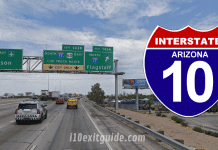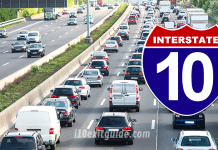The overall strategy of all Southeast Louisiana Parishes for dealing with a potential catastrophic hurricane is to evacuate as much of the risk population as possible from the path of the storm. Evacuees would then relocate to a place of relative safety outside the projected high water mark of the storm surge flooding and hurricane force winds.
The New Orleans metropolitan area represents a difficult evacuation problem due to the large population and a road system for evacuation that is limited and susceptible to flooding. It has been estimated that it could take approximately 72 hours to evacuate
most of this area. The public is encouraged to act in their best interest and voluntarily evacuate the high-risk areas before a recommended evacuation.
If you plan to evacuate, leave as early as possible before hurricane gale force winds and storm surge cause road closings. Leaving early may also help you to avoid massive traffic jams encountered late in an evacuation effort. Listen to the 2radio and television for storm reports.
An evacuation notice will be issued when a hurricane is forecasted to present a danger to the City. The timing of this notice will depend on the probability of landfall and the severity and forward speed of the storm.
Louisiana Evacuation Plan
The State of Louisiana Evacuation Plan goes into effect when any slow moving Category 3 and all Category 4 & 5 hurricanes pose a threat to our area.
The goal of the State of Louisiana Evacuation Plan is to move everyone south of Interstate 10 to areas with higher elevation.
A decision for regional evacuation is made by Parish officials after conferring with the National Weather Service, the Governor’s Office of Homeland Security and Emergency Preparedness, Louisiana State Police, Department of Transportation and Development,
National Guard, local Sheriff’s Offices, and surrounding jurisdictions.
When appropriate, Contraflow lanes may be established on Interstate highways to aid in moving a large volume of motor vehicle traffic. Contraflow means the temporary redirection of vehicular traffic. The three phases of the State of Louisiana Evacuation Plan Are:
PHASE 1 – No Highway Route Restrictions
This phase will concentrate on people who are most vulnerable to the effects of hurricane winds and water. It is directed at offshore workers, persons on coastal islands, persons living in low-lying areas, the special medical needs population, and persons aboard boats.
During Phase 1, beginning 50 hours before tropical storm winds are anticipated to strike the Louisiana coast, evacuation operations in areas south of the Intracoastal Waterway, and those areas outside levee protection that are vulnerable to category 1 or 2 storms, will be undertaken. There are no highway route restrictions.
PHASE 2 – No Highway Route Restrictions
This phase will concentrate on all people who are at risk, living:
- outside of levee protection
- inside of levee protection when an exceptionally strong storm threatens
- in a manufactured home (mobile home, RV, etc.)
- in a low-lying or flood prone area
During Phase 2, beginning 40 hours before tropical storm winds are anticipated to strike the Louisiana coast, evacuation beings in those areas south of the Mississippi River (westbank) which are protected by levees but still vulnerable to category 2 storms or larger. There are no highway route restrictions.
PHASE 3 – Highway Route Restrictions Will Apply
This is the final and most serious phase of evacuation. Authorities will put maximum emphasis on encouraging evacuation and limiting entry into the risk area. When determined appropriate by state officials, designated State Evacuation Routes will be enhanced by turning two outbound lanes into three wherever possible (i.e., Contraflow). When the storm gets close to the risk area, evacuation routes will be closed, and any persons remaining in the area, will be directed to a “Last Resort Refuse”. Note: No local Last Resort Refuse shelters are planned for Jefferson Parish / Kenner.
During Phase 3, beginning 30 hours before tropical storm winds are anticipated to strike the Louisiana coast, evacuation begins in areas of the eastbank of the Mississippi River in the New Orleans metro area that are within the levee protection boundaries, but vulnerable to a slow moving category 3 and category 4 or 5 storm. When authorized, Contraflow lanes will be implemented and highway route restrictions will apply during this period.
Phase 3: Contraflow Instructions
- I-10 West Contraflow Lanes:
- The eastbound and westbound lanes of I-10 from Clearview Parkway in Metairie to I-55 North in LaPlace will be used as westbound lanes.
- All I-10 West entrances through New Orleans, Metairie and Kenner will be used in their normal manner to gain access to I-10 West.
- I-55 North Contraflow Lanes:
- The northbound and southbound lanes of I-55 from I-12 in Hammond to the Mississippi state line will be used as northbound lanes.
- Traffic traveling I-55 North will be diverted onto I-55 North Contraflow and will only be allowed to exit at two locations: Exit 47 (LA-16) in Amite and Exit 61 (LA38) in Kentwood.
- I-59 North Contraflow Lanes:
- The northbound and southbound lanes of I-59, north of the I-10/I-12/I-59 interchange, will be used as northbound lanes.
- I-10/I-55 North to Hammond and Mississippi:
- In LaPlace, the I-10 West lanes will be diverted to I-55 North toward Hammond and Mississippi. Traffic will not be allowed to continue on I-10 West at this interchange.
- All traffic traveling on I-55 North will travel in the existing northbound lanes.
- When traffic traveling on I-55 North reaches the I-55/I-12 interchange in Hammond, I-55 will begin to Contraflow (both the north and south lanes will travel north into Mississippi).
- I-10 West to Baton Rouge:
- Traffic destined for Baton Rouge may enter the Contraflow (eastbound) lanes from Clearview Parkway, Veterans Boulevard or Williams Boulevard in New Orleans. Traffic destined for Baton Rouge may enter the Contraflow (eastbound) lanes from I-10 West via a cross- over at the Clearview Parkway overpass. This is the only opportunity to enter the Contraflow (eastbound) lanes from I-10 West without exiting and re-entering the interstate.
- In LaPlace, I-10 Contraflow traffic will be diverted onto the westbound lanes of I10 and will continue west on I-10 toward Baton Rouge.
- Lake Pontchartrain Causeway to Covington, I-12, Hammond, Mississippi:
- Northbound traffic on the Lake Pontchartrain Causeway will be diverted onto I-12 West at the US-190/I-12 interchange and will continue on I-12 West to Hammond.
- I-12 West will be diverted onto I-55 North at the I-12/I-55 interchange in Hammond.
- I-55 North will continue north into Mississippi.
- I-10 East to I-59, North to Slidell, Mississippi:
- I-10 East traffic from New Orleans will cross the I-10 Twin Spans using the three eastbound lanes.
- Contraflow of I-59 will begin at the I-10/I-12/I-59 interchange.
- At the I-10/I-12/I-59 interchange, the left and center lanes of eastbound I-10 will be diverted onto southbound I-59. Only the right lane will continue onto I-59 North.
- The I-10 East traffic will not be allowed to continue on I-10 East or enter I-12 West.
- I-59 North to Mississippi from I-10 West:
- I-10 East traffic from New Orleans will cross the I-10 East Twin Spans using the three eastbound lanes.
- Only the right lane will continue onto I-59 North .
- All traffic on I-10 West from Mississippi will be diverted on I-59 North at the I-10/I12/I-59 interchange.
- I-10 West traffic will not be allowed to continue westbound on I-10 or I-12.
- I-12 Westbound – Covington/Hammond:
- Traffic traveling on I-12 West between Covington (US-190) and Hammond (I-55) will NOT be allowed to continue on I-12 West. This traffic must divert onto I-55 North.
- Traffic traveling on I-12 West between Slidell (I-10/I-12/I-59 interchange) and Covington (US-190) will NOT be allowed to continue I-12 West. This traffic will be diverted onto US-190 West.
- Traffic traveling on US-190 West will be allowed to continue to Baton Rouge.
All Interstate exit ramps will be open to normal traffic flow. Interstate exit ramps in the Contraflow lanes will be limited and marked with variable message boards.
DURING CONTRAFLOW, MOTORISTS ARE ENCOURAGED TO CHOOSE THEIR ROUTE WISELY AND WELL IN ADVANCE. There will be many restrictions on the Interstate system. Upon entering the contraflow area, it may not be possible to change routes. Contraflow operations will begin when evacuations are initiated in Jefferson and Orleans parishes. If you do not wish to evacuate under the contraflow restrictions, your best strategy is to LEAVE EARLY before contraflow is activated.
On the road? Why not take us with you. All our websites are mobile-friendly. Visit our growing family of exit guides: I-4 Exit Guide, I-5 Exit Guide, I-10 Exit Guide, I-75 Exit Guide, and I-95 Exit Guide. Detailed exit service listings… discount lodging, camping, food, gas and more for every exit along the way!





